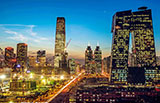Skyscraper fervor sparks concerns online
(Xinhua) Updated: 2012-09-26 06:58BEIJING - Concerns have been raised after a recent report on China's skyscrapers predicted that the country will top the world with more than one thousand tall buildings by the end of the next decade.
This news gave rise to online concerns over the country's economic prospects and urban planning.
Non-residential buildings higher than 152 meters are regarded as skyscrapers. As of July 2012, the mainland has built 470 such high-rises, with another 332 buildings under construction and 516 having been planned, according to the report.
The document estimates a total of 1.7 trillion yuan ($269 billion) will be invested into China's skyscrapers that are being constructed or planned.
The skyscraper fervor spreading across the country is linked with a controversial theory by economic researcher Andrew Lawrence, according to netizens, which show that the world's tallest buildings often rise in the wake of economic downturns.
"Will the 'Lawrence Spell' come true?" Many of them share the same worries on Sina Weibo, a Chinese Twitter-like microblogging service, citing the recent sagging stock market and weak real-estate business.
Other netizens question the meaning of vying for the country with the most skyscrapers, saying that towering buildings are only for local authorities to help improve their image.
"When we have the world's tallest building, does it mean that I will be middle class, even the world's happiest middle class person?" Asked the Internet user "Bruce_BW".
"Skyscrapers are projects of the 'face', and the drainage facilities are projects of the 'conscience'," commented another user named "hoserlee" on Sina Weibo.
The reason of the skyscraper boom, according to the report, is that developers, regulators, construction companies and architect firms all incline to approve projects, in attempts to fuel the economic growth and make profits.
But this could cause a failure in both risk management and the self-protection system of the market, it warned.
The country's third industry, or the service sector is often considered the economic base of skyscrapers but it can hardly generate sufficient market demand to prop up the surging numbers of completed skyscrapers, said the report.
Added value of China's third industry grew 9.4 percent to reach 20.5 trillion yuan in 2011 but the rate fell far below the growth of skyscrapers.
Besides, fire, earthquakes and land subsidence are serious problems that developers and regulators need to consider before planning more high-rises, experts warned.
Statistics showed that Guangzhou, Shenzhen and Shanghai ranked the top three cities in terms of the number of skyscrapers being built, while second and third-tier cities in the country are quickly catching up.
Media reported in June that Changsha, capital of Central China's Hunan province, will take just seven months to construct a building that will be 10 meters higher than the 828-meter Burj Khalifa Tower in Dubai, the world's tallest building.
In response to the skyscraper fervor, some netizens are mourning over the fading away of traditional architecture in urban cities, suggesting a need for more funds into architectural conservation.
A Weibo user nicknamed "Xiaozhu" said: "Skyscrapers may look fancy, but they lack Chinese flavor. When architecture in China all looks alike, isn't it sad for China?"
- China releases water from dam to alleviate SE Asia drought
- China to help alleviate drought along Mekong River
- Churches face severe shortage of clergy in the country
- Soybean province wants protection from GM crops
- Subsidy promotes care of mentally ill
- Anti-graft campaign targets poverty relief
- 'Zombie companies' adjust to new reality
- Car-hailing companies' subsidies unfair competition, minister say
- China-US team uses stem cells in cataract treatment
- Farmer films wild giant panda with cellphone







